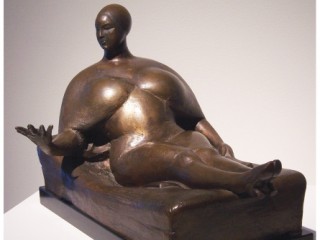
Gaston Lachaise biography
Date of birth : 1882-03-19
Date of death : 1935-10-19
Birthplace : Paris, France
Nationality : French
Category : Arts and Entertainment
Last modified : 2011-05-25
Credited as : Sculptor, robust and sensual nudes,
Gaston Lachaise, a French-born American sculptor, is best known for his robust and sensual nudes, whose elegance of gesture and suavity of finish give them sophistication and elan.
Gaston Lachaise was born in Paris on March 19, 1882. His father, a maker of fine furniture, recognized Gaston's gifts and sent him to the Ecole Bernard Palissy in 1895 to study arts and crafts. He then studied at the ecole des Beaux-Arts until 1905. Lachaise fell in love with an American art student who eventually became his wife. To earn money, he worked for a designer of Art Nouveau glass, Rene Lalique.
In 1906 Lachaise arrived in Boston and became an assistant to the academic sculptor Henry Kitson. On his own Lachaise did pieces which were freely modeled in the manner of Auguste Rodin. In 1912 Lachaise moved to New York City, where he worked as an assistant for 7 years to Paul Manship, whose sleek, mannered sculptures may have had some influence on him. Lachaise had a sculpture in the celebrated Armory Show of 1913 and received his first oneman show in 1918. About this time his style matured. His nudes bear some affinity to those of Aristide Maillol but are far more mannered. They tend to have very full breasts and ample thighs and hips, but these are countered by wasp waists, small compact heads, and arms and legs which taper to become unnaturally slender. Lachaise's bronze Standing Woman (1912-1927) is svelte, ample, assured, yet seemingly airborne.
In the 1920s and 1930s Lachaise accepted a number of commissions for garden sculptures. His fauns, dolphins, sea gulls, and the like were much admired, but his grotesquely lush earth goddesses and fiercely intertwining couples are so forward and extravagantly erotic that they offended many. Lachaise also did several portrait busts, executed in a craggy impressionistic manner. His excursions into monumental, large-scale projects were few. In 1931 he executed reliefs for the RCA Building in Rockefeller Center, New York City.
In 1935 Lachaise was given a comprehensive retrospective exhibition at the Museum of Modern Art, New York City. Though a recognized sculptor, he could not afford to have several of his pieces cast in bronze for this exhibition. At that time conservative critics and much of the general public rejected his art again as too coarse and as bordering on the obscene. Lachaise died on October 19, 1935, in New York City.
The 1964 show at the Whitney Museum of American Art, New York City, brought a fresh evaluation of Lachaise. Critics, now more knowledgable about 20th-century art, found him conservative and limited, too obsessed with sexual themes, and not concerned with matters of space.
Two older works on Lachaise, not easily obtainable, are Albert E.Gallatin, Gaston Lachaise (1924), an assessment of Lachaise in mid-career, and the Museum of Modern Art, Gaston Lachaise: Retrospective Exhibition (1935), with an essay by Lincoln Kirstein. Hilton Kramer and others, The Sculpture of Gaston Lachaise (1967), is well illustrated and critically astute. Highly recommended is G. Nordland, Gaston Lachaise, 1882-1935: Sculpture and Drawings (1964), the exhibition catalog of a show given at the Whitney Museum of American Art and the Los Angeles County Museum of Art.
















